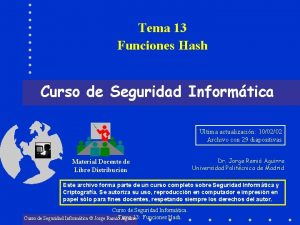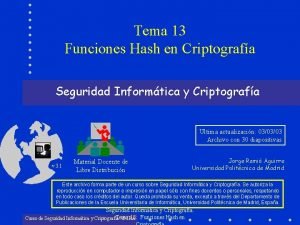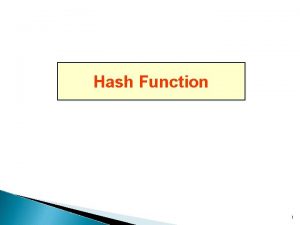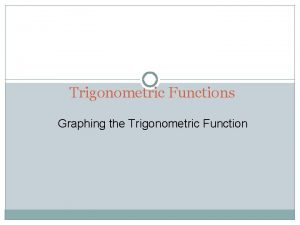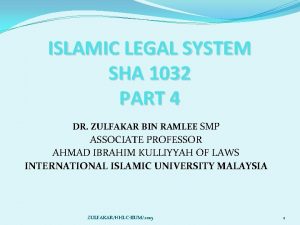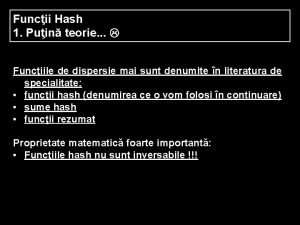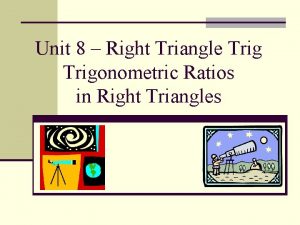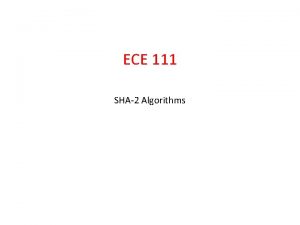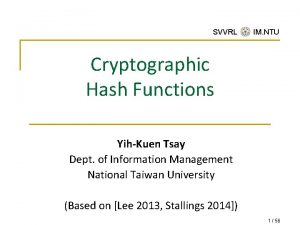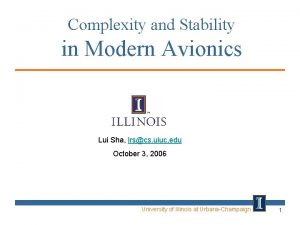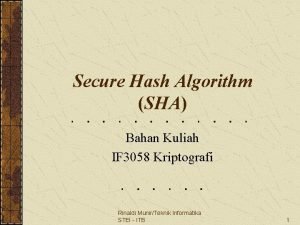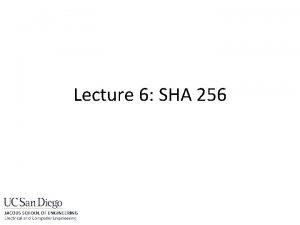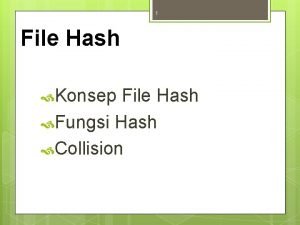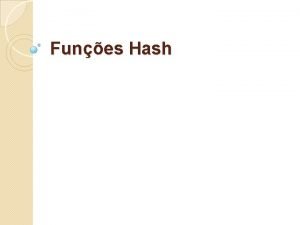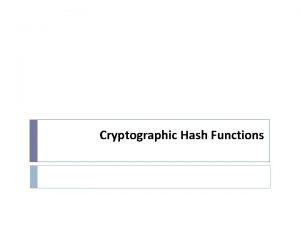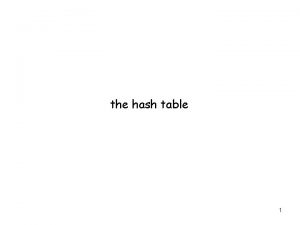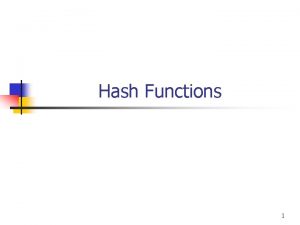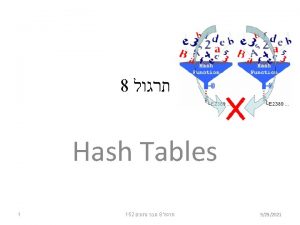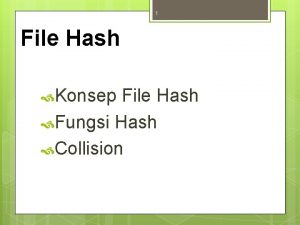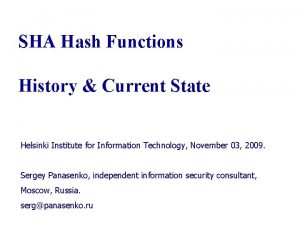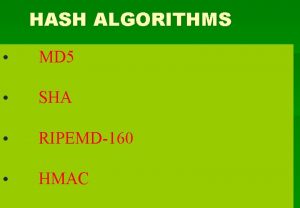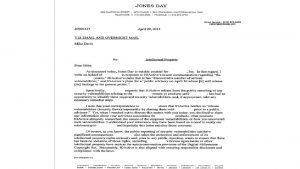SECURE HASH ALGORITHM A SEARIES OF SHA Secure






![SHA-1 Compression Function ABCDE=(F[t]+E+S 5(A)+W[t]+K[t]), >>>Shift right by 1 bit for next iteration SHA-1 Compression Function ABCDE=(F[t]+E+S 5(A)+W[t]+K[t]), >>>Shift right by 1 bit for next iteration](https://slidetodoc.com/presentation_image_h2/9499f789bb7e6db7d0e2a091dbc629e9/image-7.jpg)













- Slides: 20

SECURE HASH ALGORITHM A SEARIES OF SHA…

Secure Hash Algorithm SHA originally designed by NIST & NSA in 1993 was revised in 1995 as SHA-1 US standard for use with DSA signature scheme standard is FIPS 180 -1 1995, also Internet RFC 3174 nb. the algorithm is SHA, the standard is SHS based on design of MD 5 with key differences produces 160 -bit hash values recent 2005 results on security of SHA-1 have raised concerns on its use in future applications

How SHA Works? Digest Length=160 bit I/P Text=512 bit Sub Block size=32 bit 512/32=16 total Sub blocks No. Of Rounds=4 Iteration per round=20 Chaining Variable = 5*32=160 K[t] constant= Where t=0 to 79 O/P-> four 32 bit blocks

SHA Overview 1. 2. 3. 4. Padding: Length of the message is 64 bits short of multiple of 512 after padding. Append a 64 -bit length value of original message is taken. Divide the input into 512 -bit blocks Initialise CV 5 -word (160 -bit) buffer (A, B, C, D, E) to (A=01 23 45 67, B=89 AB CD EF, C=FE DC BA 98, D=76 54 32 10, E=C 3 D 2 E 1 F 0)

Continue… 5. Process Blocks now the actual algorithm begins. message in 16 -word (512 -bit) chunks: Copy CV into single register for storing temporary intermediate as well as the final results. Divide the current 512 -bit blocks into 16 sub-blocks, each consisting of 32 bits. Has No. Of Rounds=4, each round consisting of 20 bit /step iteration operations on message block & buffer expand 16 words into 80 words(20*4) by mixing & shifting. K[t] constant= Where t=0 to 79

![SHA1 Compression Function ABCDEFtES 5AWtKt Shift right by 1 bit for next iteration SHA-1 Compression Function ABCDE=(F[t]+E+S 5(A)+W[t]+K[t]), >>>Shift right by 1 bit for next iteration](https://slidetodoc.com/presentation_image_h2/9499f789bb7e6db7d0e2a091dbc629e9/image-7.jpg)
SHA-1 Compression Function ABCDE=(F[t]+E+S 5(A)+W[t]+K[t]), >>>Shift right by 1 bit for next iteration

SHA-1 Compression Function terms each round has 20 steps which replaces the 5 buffer words thus: (A, B, C, D, E) <(E+f(t, B, C, D)+(A<<5)+Wt+Kt), A, (B<<30), C, D) ABCDE refer to the 5 words of the buffer t is the step number f(t, B, C, D) is nonlinear function for round Wt is derived from the message block Kt is a constant value S^t circular left shift of 32 bit sub-block by t bits

Process F(t) in each SHA-1 round where g can be expressed as: ROUND 1: (b AND c) OR ((NOT b) AND (d)) same as MD 5 ROUND 2: b XOR c XOR d ROUND 3: (b AND c) OR (b AND d) OR (c AND d) ROUND 4: b XOR c XOR d

Creation of 80 -word input Wt Adds redundancy and interdependence among message blocks

SHA-1 verses MD 5 brute force attack is harder (160 vs 128 bits for MD 5) not vulnerable to any known attacks (compared to MD 4/5) a little slower than MD 5 (80 vs 64 steps) both designed as simple and compact optimised for big endian CPU's (SUN) vs MD 5 for little endian CPU’s (PC)

Revised Secure Hash Standard NIST issued revision FIPS 180 -2 in 2002 adds 3 additional versions of SHA-256, SHA-384, SHA-512 Different lengths of Message Digest in bits designed for compatibility with increased security provided by the AES cipher structure & detail is similar to SHA-1 hence analysis should be similar but security levels are rather higher


1. Padding, 2. Append Length, 3. Divide the input into 1024 - bit blocks

4. Initialization Of Chaining Variable 8*64= 512 bits A, B, C, D, E, F, G, H

5. Process Blocks heart of the algorithm processing message in 1024 -bit blocks consists of 80 rounds updating a 512 -bit buffer TEMP CHAINING VARIABLES. using a 64 -bit value Wt derived from the current message block and a round constant based on cube root of first 80 prime numbers

SHA-512 Round Function

SHA-512 Round Function Let us look in more detail at the logic in each of the 80 steps of the processing of one 512 -bit block (Figure). Each round is defined by the following set of equations:

SHA-512 Round Function where t =step/round number; 0 t 79 Ch(e, f, g)= (e AND f) XOR (NOT e AND g) the conditional function: If e then f else g Maj(a, b, c)= (a AND b) XOR (a AND c) XOR (b AND c) the function is true only of the majority (two or three) of the arguments are true. Sum (ai)= RORT (ai By 28 Bit) XOR RORT (ai By 34 Bit) XOR RORT (ai By 39 Bit) Sum (ei)= RORT (ei By 14 Bit) XOR RORT (ei By 18 Bit) XOR RORT (ei By 41 Bit) ROTRn(x) = circular right shift (rotation) of the 64 -bit argument x by n bits Wt = a 64 -bit word derived from the current 512 -bit input block (i. e: - Kt = a 64 -bit additive constant Message Digest)

SHA-512 Round Function
 Algoritmo abcde
Algoritmo abcde Tema de hash hash
Tema de hash hash Davies meyer construction
Davies meyer construction Domain of tangent function
Domain of tangent function Sha
Sha Functie hash
Functie hash Master sha tao center
Master sha tao center 60 3090 triangle
60 3090 triangle Sha 3
Sha 3 Sha in network security
Sha in network security Sha questionnaire
Sha questionnaire Sha 256
Sha 256 Sha0
Sha0 Ntu
Ntu What does hmac stand for
What does hmac stand for Rei ticker symbol
Rei ticker symbol Astd inf meta
Astd inf meta Sha questionnaire
Sha questionnaire Generate sha-1 android studio
Generate sha-1 android studio Lui sha uiuc
Lui sha uiuc Sha questionnaire
Sha questionnaire
